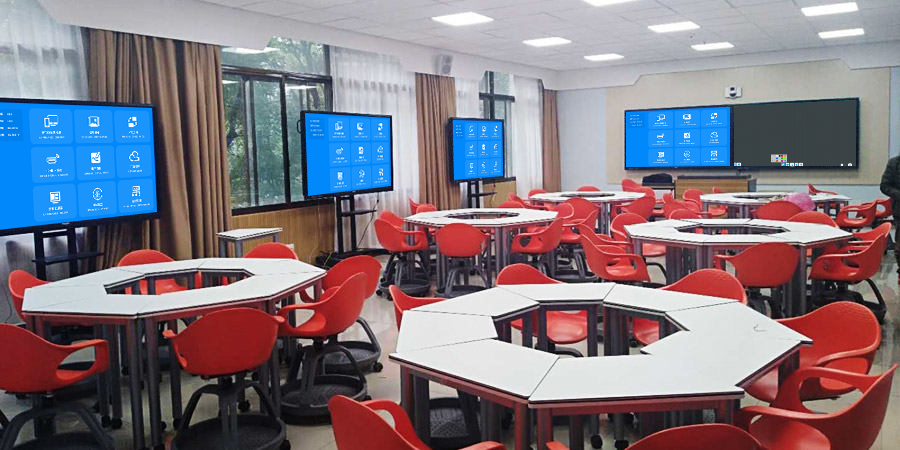Group Discussions: A Collaboration Solution with Phone Screen Mirroring
In group discussions, phone screen mirroring is becoming a key link that breaks down information silos. With the support of Bijie screen mirroring devices, fragmented ideas and temporary materials from phones can be quickly projected and flexibly flowed. This makes in-group discussions more dynamic and inter-group communication smoother, transforming discussions from “working in isolation” to “efficient collaboration.”
In-Group Collaboration: Phone Mirroring Makes Ideas Tangible in Real Time
Each group’s Bijie screen mirroring receiver allows members’ phones to connect quickly. Whether you have an iOS or Android system, you can complete the connection in 3 seconds by scanning a QR code, using NFC tap-to-connect, or a built-in system mirroring function. There’s no hassle of installing software, and older phones can also mirror content stably. During a group discussion, someone can take a photo of an initial framework on a whiteboard with their phone and mirror it to the group screen, allowing others to gather around the big screen and add details. Someone else can mirror key ideas they’ve noted in their phone’s memo pad, making them visible to the whole group with one tap and avoiding the inefficiency of “reading notes” or “passing around a phone.”
Bijie’s screen mirroring devices support simultaneous split-screen mirroring from multiple phones. 3-4 people in a group can each mirror their own content. Proposal drafts, data screenshots, and case links can be displayed side by side on the group screen, making it easy to compare different ideas at a glance. The mirrored content is also updated in real time. If someone modifies a proposal framework on their phone, the screen on the group display changes simultaneously, so you don’t have to re-mirror repeatedly. This increases the speed of forming a consensus within a group by 50%.
Inter-Group Communication: Phone Mirroring Makes Results Flow Efficiently
The discussion results of each group can be easily “pushed” to the large screen in the main hall via phone mirroring. The multi-screen linkage function of Bijie’s screen mirroring devices allows the main screen to display the mirrored content of 3-6 groups at the same time. The proposal drafts and discussion minutes that each group has mirrored from their phones are displayed side by side in a split-screen view, making it easy for everyone to compare. If another group has questions about a certain group’s content, they can scan the corresponding QR code on that group’s display with their phone, and their annotated suggestions will appear in that group’s mirrored area in real time. There’s no need to get up to pass notes, and inter-group interaction is instant and intuitive.
When you need to focus on one group’s results for an in-depth discussion, the presenter can switch the mirrored content with their phone. With a tap on the screen, they can enlarge one group’s mirrored content onto the main screen and, after the discussion, switch back to the multi-group split-screen view with a single click. The operation is simple and doesn’t interrupt the pace of the discussion. The mirrored content of each group can also be automatically recorded by the Bijie device, preventing important ideas from being missed because they weren’t noted in time.
Practical Value for Multi-Scenario Adaptation
Small Team Discussions (4-6 people per group)
Phone mirroring is especially flexible when group members are seated around a table. If someone suddenly thinks of a case study, they can search for a related video on their phone and mirror it directly so the whole group can watch it synchronously. If there are disagreements during the discussion, they can film their own draft ideas with their phones and mirror them side-by-side for comparison, and they can quickly find common ground. There’s no need to prepare a computer; you can pull up materials from your phone at any time, making the discussion atmosphere more relaxed and preventing device operations from interrupting the flow of ideas.
Cross-Departmental Collaborative Discussions
When group members from different departments come together in a group, phone mirroring can break down “material barriers.” A member from the marketing department can mirror screenshots of user feedback from their phone, and a member from the technical department can mirror a real-time technical feasibility analysis. They can discuss them side by side on the group screen without having to go back and forth transferring files. Each department’s exclusive materials are on their phones, so they can be mirrored and used at any time, which greatly improves the smoothness of cross-departmental collaboration.
Outdoor/Temporary Discussions
In a venue without fixed meeting equipment, a portable Bijie mirroring device paired with a projector or large screen can still support group discussions. When doing research, you can form temporary groups in a conference room and use your phones to mirror photos and videos taken on-site to discuss strategies based on the real-world situation. In a training session, students can form temporary groups and use their phones to mirror their homework results for immediate in-group comments. The discussion scenario is more flexible because it’s not limited by fixed equipment.
The combination of group discussions and phone screen mirroring, with the support of Bijie’s mirroring devices, turns a phone from a “personal information carrier” into a “collaboration tool.” Without complex preparations, fragmented materials can be quickly aggregated, and without cumbersome operations, discussion results can be efficiently flowed. This ensures that every group discussion can focus on the exchange of ideas rather than the transfer of information, redefining the high-efficiency model for group discussions.